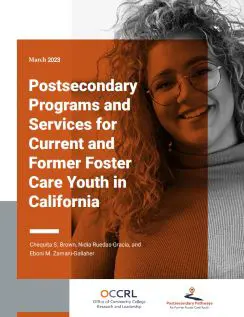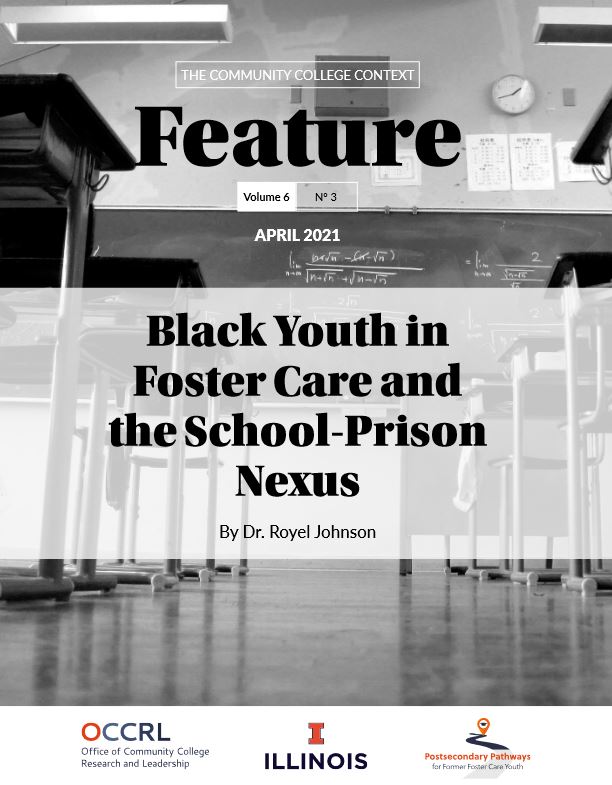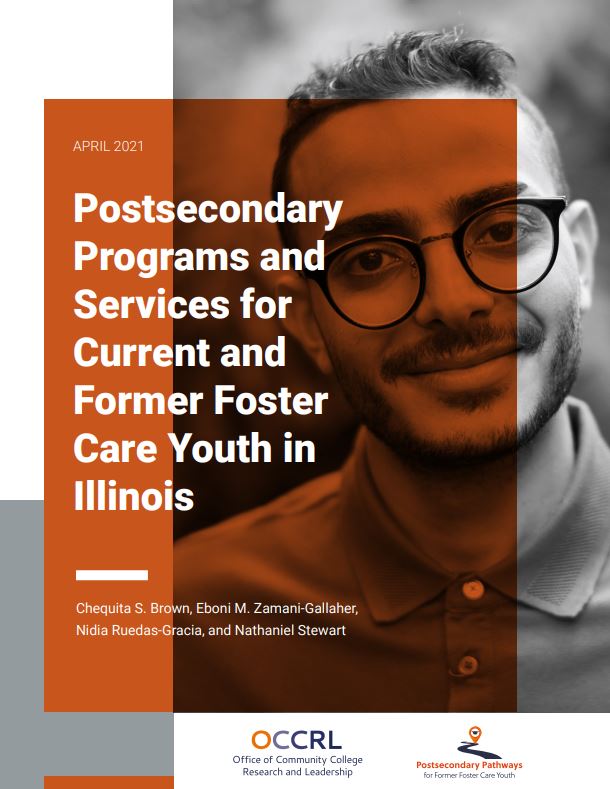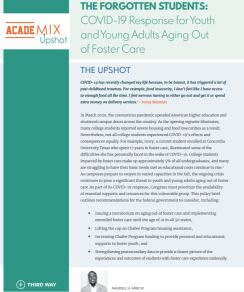
Postsecondary Pathways - for Former Foster Care Youth
This project has been completed and is no longer active.
However, we hope you are able to utilize its resources.
The Postsecondary Pathways for Former Foster Care Youth (PP-FFCY) reflects OCCRL’s commitment to examining and developing postsecondary pathways that support mobility for first-generation, underserved, and minoritized populations, as well as strengthening career pathways to promote seamless transitions from college to careers. This project endeavors to examine postsecondary access, opportunities, and supports for foster youth in Illinois and other states across the county in addressing access and outcomes of FFCY in Career Technical Education (CTE).
Purpose
The Postsecondary Education Pathways for Former Foster Care Youth (PP-FFCY) project is an exploratory study focused on postsecondary pathways for current and former foster youth in Illinois. OCCRL is conducting a comprehensive-needs assessment that provides a descriptive profile of current and former foster youth populations in Illinois; examines postsecondary access, opportunities, and supports for foster youth in Illinois; and addresses disparities in career and technical education (CTE) programs. This project reflects OCCRL’s commitment to examining and developing postsecondary pathways that support mobility for first-generation, underserved, and minoritized populations as well as strengthening and supporting career pathways to promote seamless transitions from college to careers.
Resources
OCCRL aims to increase postsecondary awareness, access, and attainment for current and former foster care youth by providing information on programs and other resources that offer holistic support and services. View the list of postsecondary programs and services.
Strategies to Cultivate a Foster-Friendly Culture on Community College Campuses
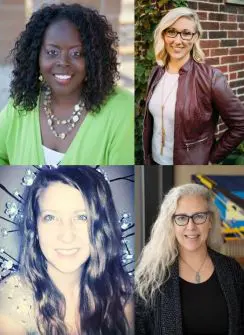 In this episode, Chequita Brown talks with Kate Danielson of the organization Foster Progress, as well as with Anna Wandtke and Tricia Wagner of Rock Valley College in Rockford, Illinois. The group discusses how to cultivate a foster-friendly culture at Illinois community colleges.
In this episode, Chequita Brown talks with Kate Danielson of the organization Foster Progress, as well as with Anna Wandtke and Tricia Wagner of Rock Valley College in Rockford, Illinois. The group discusses how to cultivate a foster-friendly culture at Illinois community colleges.
Navigating College as a Foster Care Alum
 In this episode, OCCRL research assistant Chequita S. Brown talks with Jonathan Stacy, a sophomore at Heartland Community College who is pursuing his studies and a possible career in criminal justice.
In this episode, OCCRL research assistant Chequita S. Brown talks with Jonathan Stacy, a sophomore at Heartland Community College who is pursuing his studies and a possible career in criminal justice.
Listen to the podcast and view the transcript.
Key Elements to Successfully Connecting Foster Care Youth to Educational Resources for Postsecondary Success
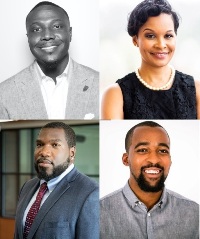 In this episode, Nathaniel Stewart talks with Mauriell Amechi, Regina Gavin Williams, and Blayne Stone Jr. about how the transitions and pathways to postsecondary education are similar and different for Black former foster care students. The scholars also discuss key elements to successfully connect foster care youth to educational resources that help advance the postsecondary education opportunities for this student population.
In this episode, Nathaniel Stewart talks with Mauriell Amechi, Regina Gavin Williams, and Blayne Stone Jr. about how the transitions and pathways to postsecondary education are similar and different for Black former foster care students. The scholars also discuss key elements to successfully connect foster care youth to educational resources that help advance the postsecondary education opportunities for this student population.
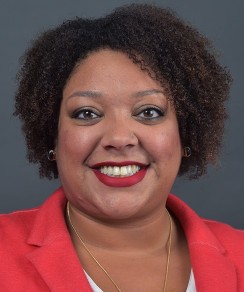
Maddy Day
The Impact of Campus-Based Support Programming on Foster Care Collegians' Postsecondary Access and Retention
In this episode, Chequita Brown of OCCRL talks with Maddy Day about the Fostering Success initiative in Michigan and the impact of campus-based support programming on foster carecollegians' postsecondary access and retention.

Patricia Palmer
How Youth-in-Care in Illinois Can Access Educational Resources to Pursue a Postsecondary Education
In this episode, OCCRL research assistant Chequita Brown continues the conversation on foster care youth by talking about with Patricia Palmer about accessing available resources in Illinois for youth-in-care who want to pursue a postsecondary education.

Nidia Ruedas-Gracia
Conceptualizing 'Sense of Belonging' Among Students From Historically Minoritized Racial Groups Within Higher Education
In this episode, Colvin Georges Jr., a research associate at OCCRL, talks with Dr. Nidia Ruedas-Gracia about what it means to have a sense of belonging and discusses her research in this area. They also discuss how a sense of belonging affects college students from historically minoritized racial groups.
Postsecondary Programs and Services for Current and Former Foster Care Youth in California
By Chequita S. Brown, Nidia Ruedas-Gracia, and Eboni M. Zamani-Gallaher
This brief highlights postsecondary programs and services in California that support youth in care, in addition to young adults who are aging out of foster care. Read more.
Tracking College-to-Career Pathways for Foster Youth
By Chequita S. Brown
In this OCCRL Thought Paper, Chequita S. Brown relates how tracking the data of students with foster care experience helps to recognize them as a legitimate student population. She offers recommendations on how to do this and conveys the many obstacles that can hinder the academic and career success of foster youth. Read more.
Black Youth in Foster and the School-Prison Nexus
By Royel Johnson
In this OCCRL Feature Brief, Dr. Royel Johnson argues that the foster care system, and more specifically congregate care facilities, are part and parcel to the enhancement of carceral state power. Read more.
Postsecondary Programs and Services for Current and Former Foster Care Youth in Illinois
By Chequita S. Brown, Eboni Zamani-Gallaher, Nidia Ruedas-Gracia, and Nathaniel M. Stewart
This research brief provides an overview of programs and services that helps strengthen postsecondary pathways for current and former foster youth in Illinois. Read more.
Foster Youth and Basic-Needs Insecurity
By Dra. Nidia Ruedas-Gracia, Chequita S. Brown, Dr. Mauriell Amechi, Dr. Eboni Zamani-Gallaher, and Nathaniel M. Stewart
This article discusses how COVID-19 has intensified the vulnerabilities of foster youth and former foster youth, many of whom are Black, Native American, Alaska Native, and multiracial children who have a higher rate of placement into foster care than White youth (Federal Interagency Forum on Child and Family Statistics, 2016). Read more.
(From the Fall 2020 UPDATE on Research and Leadership)
Exploring Equity in Postsecondary Education
By Heather L. Fox, Eboni M. Zamani-Gallaher
This chapter examines how postsecondary practitioners are encouraged to work collaboratively with child welfare agencies and other community-based organizations to identify and implement culturally responsive supports for former foster youth to promote early academic achievement. Read more.
The Forgotten Students: COVID-19 Response for Youth and Young Adults Aging Out of Foster Care
By Mauriell H. Amechi
This policy brief outlines recommendations for Congress to consider regarding the country's COVID-19 response, in an effort to prioritize the availability of essential supports and resources for youth and young adults who are aging out of foster care. Read more.
Underserved: Supporting Students with Foster Care Experiences
The number of students with foster care experience enrolled at colleges and universities nationwide has nearly doubled within the last two decades (National Working Group on Foster Care and Education, 2018; Wolanin, 2005). To ease young people’s transition from foster care to college, several two- and four-year institutions initiated targeted campus programming and wrap-around supports to increase retention and college success. Despite their growing presence on campus, current and former foster youth remain largely overlooked as a student population at postsecondary institutions. Myriad of factors contribute to foster youths' institutional invisibility, such as students' hesitancy to disclose their foster care background (Kinarsky, 2017; Tobolowsky et al., 2018) and postsecondary professionals' inability to identify this vulnerable population (Dworsky & Perez, 2010; Piel et al., 2020). These factors pose a problem for foster youth on campus because unrecognized student populations are often underserved and unsupported.
Research documents various barriers foster youth may encounter while in and post-foster care. Foster youth often experience placement instability and frequent school changes that disrupt their academic progression (Davis, 2006). Though over 70% aspire to earn a college degree, foster youths' educational gaps often leave them ill-prepared for college rigor (Dworsky & Perez, 2010; National Working Group on Foster Care and Education, 2018; Piel, 2018; Wolanin, 2005). Non-academic barriers such as housing insecurity, mental and emotional instability, and insufficient adult and financial support are detrimental to foster youths' educational attainment (Fryar et al., 2017; Hallett & Westland, 2015; McMillen et al., 2005; Okpych & Courtney, 2018). Of those who matriculate at a postsecondary institution, roughly 3%-11% will earn a college degree (Dworsky, 2018; Wolanin, 2005).
Clearly, students with foster care experience require campus-based support and advocacy to address their holistic needs as college students. Although postsecondary professionals are frontline support for diverse student populations on campus, staff and faculty are unaware of and unprepared to address foster youths' unique challenges related to having been in foster care and its impact (e.g., mentally, limited familial support, housing insecurity) on their college success (Dworsky, 2018; Tobolowsky et al., 2017). Over the years, the changing demographics on Illinois college campuses have inspired a range of support programs and resources that cater to the needs of various student populations such as military affiliate, LGBTQUIA+ , disabled, international, low-income, and first-generation students. However, direct services and support for students with foster care backgrounds are largely non-existent on these same Illinois college campuses.
Recently, the Illinois General Assembly enacted the Higher Education Housing and Opportunities Act (2021) to address the void in services for current and former foster youth at postsecondary institutions. Effective August 1, 2022, postsecondary institutions must designate at least one campus employee within financial aid, campus housing, or any select department as a liaison for college students with foster care experience and homeless students. Liaisons should be trained and knowledgeable of resources and support available to current/former foster youth and homeless students on campus. In addition to providing support, liaisons must track students' retention and graduation rate at the institution (Section (10)(b)(4)), and train other campus employees to identify students with foster care experience and housing insecurity issues enrolled at the institution (Section (10)(b)(10)).
Indeed, implementing the campus liaison role is a step towards increasing awareness of current and former foster youth on campus. Given the range of compounding challenges facing students with foster care experience, this population would benefit from supportive, highly skilled campus liaisons and other professionals at the institution who can address academic and non-academic barriers that impede educational attainment. While the Higher Education Housing and Opportunities Act (2021) is in effect, it is in the initial stages and has yet to be operationalized on many Illinois campuses. Nevertheless, there are strategies current campus professionals can employ to enhance their understanding and skills to serve this vulnerable student population.
- Educate yourself. It is imperative to understand common barriers to foster youths' college success. An awareness of potential challenges provides insight into possible solutions and approaches to address certain issues as they arise. For example, foster youth are likely to have limited financial support and knowledge about financial resources available for college. Campus professionals can learn about and be prepared to share financial aid resources for foster youth, independent students, and homeless students.
Housing security is another common challenge for foster youth. Foster youth are likely to matriculate at a two-year institution (Havlicek et al., 2021), yet most two-year institutions do not provide campus housing. Although four-year institutions typically offer campus housing and a meal plan, without year-round housing, students with foster care backgrounds and homeless students may lack lodging during holidays and school breaks. Campus professionals can increase their knowledge of housing and dining policies at their institution. Since most four-year institutions offer year-round housing options for international students, it is helpful to ask if similar arrangements are available for other student populations with unique housing needs, such as foster youth. Educating oneself on challenges and thinking through potential solutions related to foster youths' unique needs can prepare professionals to better support and advocate for current and former foster youth on campus.
- Avoid making assumptions. It is easy to assume undergraduate students arrive on campus with supportive networks (e.g., family, friends, mentors). However, students with foster care experience will likely begin their college journey with limited adult support and guidance. Without this understanding, campus professionals can make seemingly casual assumptions about a student that unknowingly triggers unhealthy memories or emotions. For example, in my own practice, I made a similar mistake, when asking students if they were looking forward to seeing their parents for Family Weekend. One student's facial reaction and body language was telling. It seemed I'd made her uncomfortable. Later in the semester, that student disclosed details about her family dynamic and independent student status, which explained her reaction to the family weekend comment. This experience taught me that general inquiries are more appropriate when interacting with students. Instead of assuming students would participate in campus-sponsored events such as parents' and family weekends, best practices suggest making a general inquiry like, "there are several events on campus this weekend. Are you planning to participate in any of the activities?". This approach allows campus staff to inquire about students' socialization on campus without making inappropriate assumptions that can be emotionally triggering.
- Leverage existing campus supports. Although some institutions do not offer specialized support for collegians with foster care backgrounds, campus professionals can leverage training resources and supports through existing campus departments. Cross-campus collaborations among support offices such as counseling services, student housing, and financial aid can yield strategies to best serve current and former foster youth at the institution. For instance, academic departments can collaborate with student housing to establish living-learning communities for students with foster care backgrounds to support their academic and social development (Amechi, 2016). Further, collaborations with other campus units, such as social work and psychology departments, may provide access to faculty, staff, and graduate students who are knowledgeable of and can offer training related to the needs and challenges facing students with foster care backgrounds (Geiger et al., 2016). While it may not be feasible to establish and implement a campus-based program that targets students with foster care backgrounds, postsecondary professionals can explore cross-campus collaborative efforts to identify and provide services that equitably support this traditionally underserved population on campus.
In sum, college students with foster care experience are a growing population at postsecondary institutions. Though many aspire to earn a college degree, only a small percentage will accomplish this goal. Indeed, no one solution will address the needs of this student population, but having targeted support can surely ease the transition from foster care to college and beyond. As more current and former foster youth matriculate at colleges and universities, it is crucial that frontline campus support units (e.g., academic advising, financial aid, student housing, counseling) are aware of and prepared to support their holistic needs. Without trained professionals who can recognize and support their academic and social needs, current and former foster youth will remain an underserved student population on campus.
References
